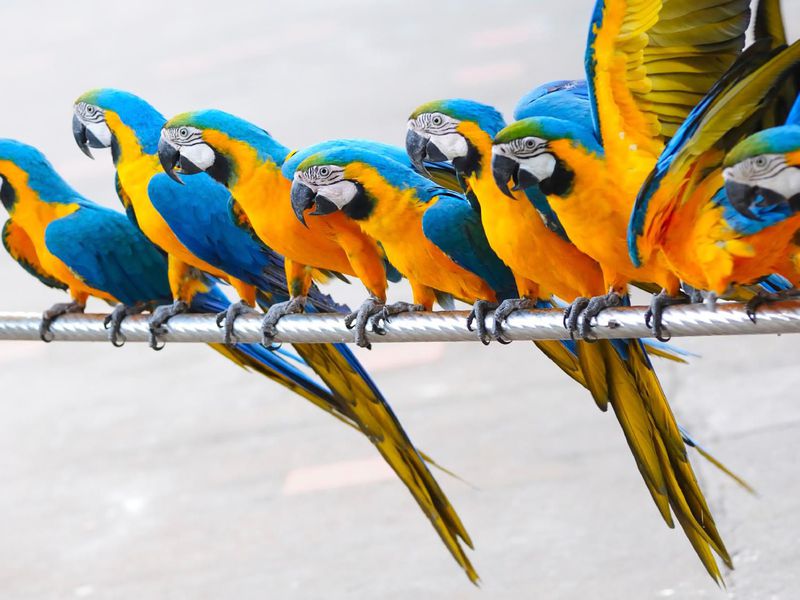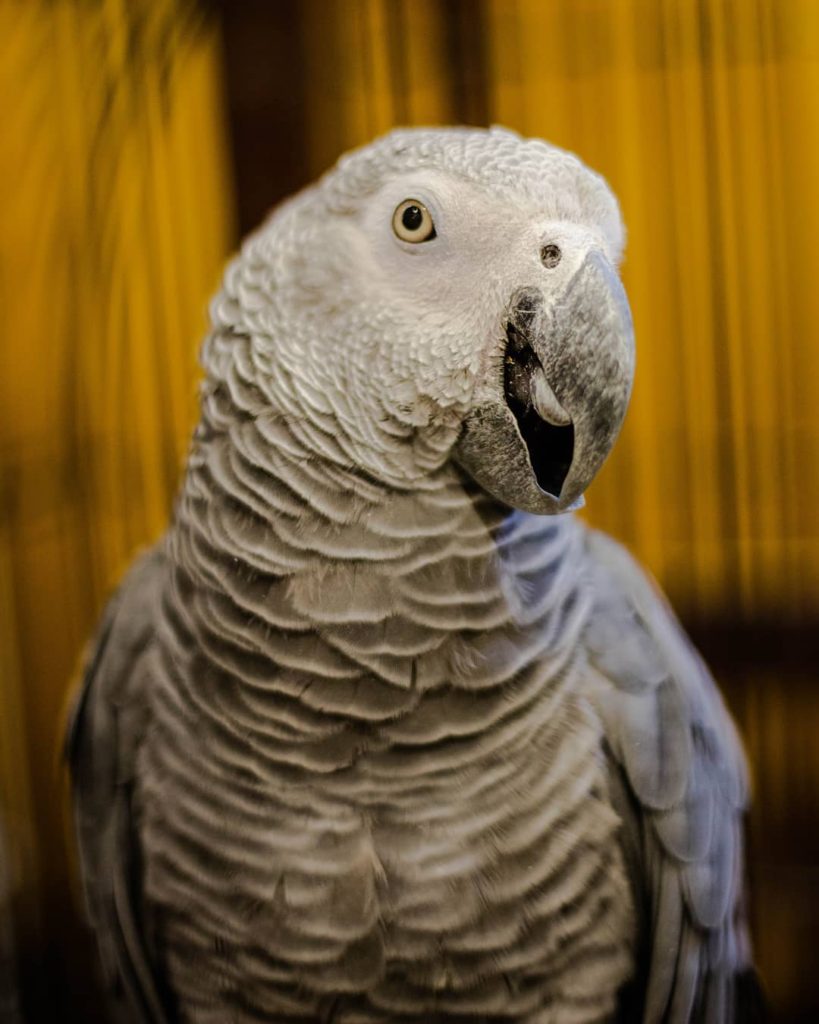They taste with the roofs of their mouths
After dogs, cats, and fish, birds are America’s fourth most popular pet. The United States has an estimated 14 million birds in captivity, the majority of which are parrots. And it’s easy to see why: these avian creatures are irresistible with their vibrant colors, acrobatic movements, and often goofy personalities.
Pet parrots can be wonderful, demanding friends, but for those who are more accustomed to fluffy mammalian pets, they can pose some surprising obstacles. Long-lived, clever, and extremely social birds require extra attention and enrichment; otherwise, they may develop harmful habits and become bored and agitated to the point of plucking off their feathers.
While some pet parrots are obtained from breeders, the trade in exotic parrots is a major industry around the world, and it contributes considerably to their extinction in the wild. Thankfully, trafficking in wild birds has decreased in the United States following the implementation of the 1992 Wild Bird Conservation Act and CITES prohibitions on exotic species imports.
In honor of the 14th annual National Bird Day, here are 14 interesting facts about parrots:

1. Certain parrots grind their calcium supplements.
As a famous research subject, the African grey parrot Alex was believed to have the intelligence of a 5-year-old human. The psittacine tribe can now claim another impressive feat: the ability to use tools. Researchers at the Universities of York and St. Andrews witnessed captive larger vasa parrots (Coracopsis vasa) pulverizing cockle shells with date pits and pebbles. Male vasas consumed the powder and then regurgitated a calcium-rich snack for females before mating. Be thankful that you received chocolates.
2. Parrot Toes Are Zygodactyl
Parrots, like other birds, have four toes on each foot. However, instead of the typical three-in-front-one-behind layout, parrot toes are designed for optimum grip: two in front and two behind, similar to two pairs of opposable thumbs. Their distinctive feet, along with beaks capable of cracking even the toughest nuts, make them powerful feeders as well as agile climbers.
3. Polly Wants Mutton, Too
Many parrots are omnivorous, meaning they will eat almost anything, including fruit, seeds, nuts, insects, and even meat. Some species, such as the rainbow-colored lories and lorikeets of the South Pacific, feed nearly exclusively on nectar with brush-tipped tongues, however, these birds have lately been observed eating meat at feeding stations in Australia. Native kea (Nestor species) were first seen attacking and killing sheep in New Zealand in 1868, and they were hunted until 1986 when they were awarded protected protection.
4. Not All Parrots Are Tropical
The majority of the over 350 known parrot species live in the tropical and subtropical regions of Australia, Asia, Central and South America, and Africa. However, some parrots defy geographical stereotypes. Keas live in New Zealand’s alpine regions and nest in ground burrows, whereas the endangered maroon-fronted parrot (Rhynchopsitta terrisi) lives at 6,000 feet in Mexico’s Sierra Madre Oriental mountains.

5. A Third of the World’s Parrots Face Extinction
More species are frequently added to the IUCN Red List of Threatened Species as a result of habitat degradation and ongoing poaching for the pet trade. A November research, for example, discovered that logging had killed 99 percent of the African grey (Psittacus erithacus) population in Ghana, endangering natural populations of one of the most iconic parrot species.
6. Parrots Usually Match Their Mates
With a few significant exceptions, men and females in most parrot species appear nearly identical. Telling a boy bird from a girl bird requires a good eye—and, in most cases, a laboratory test. However, certain species, such as the Solomon Island eclectus (Eclectus roratus), are so unique that for many years, people mistook them for separate bird species.
Males are vivid emerald green with flame-colored beaks, and females finish off their crimson and royal blue outfits with black beaks and a bright scarlet head.
7. Parrots Taste With the Tops of Their Beaks
Though parrots have some taste glands in the back of their throats, the majority of their 300 or so taste buds are found on the tops of their mouths. The birds’ palette may appear to be little in comparison to the 10,000 taste receptors in a human mouth, yet parrots do have specific dietary preferences.
8. The Heftiest Parrot Weighs as Much as a Cat
Parrots come in an astounding variety of shapes and sizes. The small buff-faced pygmy (Micropsitta pusio) weighs only an ounce and is around the size of an adult human finger. The world’s longest parrot, the dazzling hyacinth macaw (Anodorhynchus hyacinthinus), is approximately 3.5 feet from tip to tail. The New Zealand kakapo (Strigops habroptilus), which is flightless and nocturnal, is the heavier species. A fully developed male can weigh up to nine pounds—the normal weight of an adult housecat.
9. Your Pet Parrot May Outlive You
Many parrots have human-like lifespans, which many people are unaware of while looking for a parrot as a friend. Larger species, such as macaws and cockatoos, are known to live for 35 to 50 years. Tarbu, an African grey in England, lived to the age of 55. Cookie, an 82-year-old Major Mitchell’s cockatoo (Lophochroa leadbeateri) from Brookfield Zoo in Chicago, is the world’s oldest parrot.
10. Parrot Feathers Contain Antibacterial Pigments
A parrot’s bright plumage has a specific defense against damage: Psittacofulvins, a bacteria-resistant pigment produced exclusively by parrots, give the birds’ feathers their red, yellow, and green hue. A 2011 study published in Biology Letters demonstrated that exposing different feather hues to a bacterium strain protected the plumage from deterioration.
11. Some Parrots Migrate
The fast parrot (Lathamus discolor) and orange-bellied parrot (Neophema chrysogaster) migrate annually across the Bass Strait between Australia and Tasmania, while most other species stay in their home ranges year-round. Both species are considered critically endangered.
12. The World Record Holder Knew More Than 1,700 Words
In 1995, the Guinness Book of World Records honored Puck, a blue parakeet, for his impressive vocabulary of 1,728 words. Amazon parrots can also sing, such as Groucho, who performed “How Much Is That Doggie in the Window” on TV in 2010.
13. The Black Palm Is the Panda of Parrots
The black palm cockatoo, which is native to the South Pacific rainforests, is one of the most difficult birds to breed and keep in captivity. Even wild pairings struggle to successfully nurse chicks, which frequently perish at one year of age. The roots of their reproductive issues are unknown, however, they may be linked to their photosensitive skin, which reacts to natural sunshine.
14. A Parrot-Proof Tracker Is on the Horizon
Understanding the behavior of wild parrots is challenging due to their canopy-dwelling nature. Furthermore, GPS-tracking studies of parrots are relatively rare, as the birds are skilled at removing foreign things from their bodies. A 2015 study published in The Auk may help scientists better monitor these elusive species.
By encasing GPS transmitters in bite-proof plastic, the researchers were able to track a group of keas in New Zealand with no apparent harm to the birds.
Source"www.smithsonianmag.com/science-nature/14-fun-facts-about-parrots"

